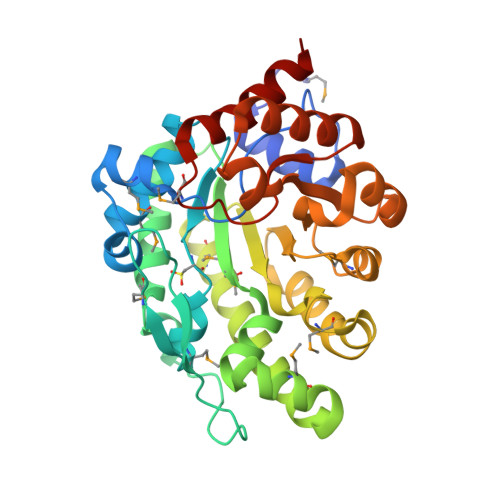Structure of the Corrinoid:Coenzyme M Methyltransferase Mtaa from Methanosarcina Mazei
Hoeppner, A., Thomas, F., Rueppel, A., Hensel, R., Blankenfeldt, W., Bayer, P., Faust, A.(2012) Acta Crystallogr D Biol Crystallogr 68: 1549
- PubMed: 23090404
- DOI: https://doi.org/10.1107/S090744491203853X
- Primary Citation of Related Structures:
4AY7, 4AY8 - PubMed Abstract:
The zinc-containing corrinoid:coenzyme M methyltransferase MtaA is part of the methanol-coenzyme M-methyltransferase complex of Methanosarcina mazei. The whole complex consists of three subunits: MtaA, MtaB and MtaC. The MtaB-MtaC complex catalyses the cleavage of methanol (bound to MtaB) and the transfer of the methyl group onto the cobalt of cob(I)alamin (bound to MtaC). The MtaA-MtaC complex catalyses methyl transfer from methyl-cob(III)alamin (bound to MtaC) to coenzyme M (bound to MtaA). The crystal structure of the MtaB-MtaC complex from M. barkeri has previously been determined. Here, the crystal structures of MtaA from M. mazei in a substrate-free but Zn(2+)-bound state and in complex with Zn(2+) and coenzyme M (HS-CoM) are reported at resolutions of 1.8 and 2.1 Å, respectively. A search for homologous proteins revealed that MtaA exhibits 23% sequence identity to human uroporphyrinogen III decarboxylase, which has also the highest structural similarity (r.m.s.d. of 2.03 Å for 306 aligned amino acids). The main structural feature of MtaA is a TIM-barrel-like fold, which is also found in all other zinc enzymes that catalyse thiol-group alkylation. The active site of MtaA is situated at the narrow bottom of a funnel such that the thiolate group of HS-CoM points towards the Zn(2+) ion. The Zn(2+) ion in the active site of MtaA is coordinated tetrahedrally via His240, Cys242 and Cys319. In the substrate-free form the fourth ligand is Glu263. Binding of HS-CoM leads to exchange of the O-ligand of Glu263 for the S-ligand of HS-CoM with inversion of the zinc geometry. The interface between MtaA and MtaC for transfer of the methyl group from MtaC-bound methylcobalamin is most likely to be formed by the core complex of MtaB-MtaC and the N-terminal segment (a long loop containing three α-helices and a β-hairpin) of MtaA, which is not part of the TIM-barrel core structure of MtaA.
- Structural and Medicinal Biochemistry, Centre of Medical Biotechnology (ZMB), University of Duisburg-Essen, Campus Essen, 45117 Essen, Germany.
Organizational Affiliation:






















